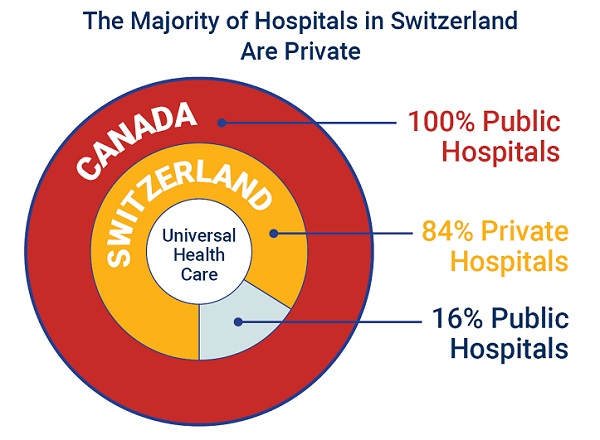Health
The People Cheering Brian Thompson’s Murder Can’t Have the Medical Utopia That They Want

Whether private or public, third-party payment for health care is a huge problem.
Evoking a collective scream of despair from socialists and anti-corporate types, police in Pennsylvania arrested Luigi Mangione, a suspect in the murder of UnitedHealthcare CEO Brian Thompson. Thompson, they insist, stood in the way of the sort of health care they think they deserve and shooting him down on the street was some sort of bloody-minded strike for justice.
The assassin’s fans—and the legal system has yet to convict anybody for the crime—are moral degenerates. But they’re also dreaming, if they think insurance executives like Thompson are all that stands between them and their visions of a single-payer medical system that satisfies every desire. While there is a lot wrong with the main way health care is paid for and delivered in the U.S., what the haters want is probably not achievable, and the means many of them prefer would make things worse.
“Unlimited Care…Free of Charge”
“It is an old joke among health policy wonks that what the American people really want from health care reform is unlimited care, from the doctor of their choice, with no wait, free of charge,” Michael Tanner, then of the Cato Institute, quipped in 2017.
The problem, no matter how health care is delivered, is that it requires labor, time, and resources that are available in finite supply. Somebody must decide how to allocate medications, treatments, physicians, and hospital beds, and how to pay for it all. A common assumption in some circles is that Americans ration medicine by price, handing an advantage to the wealthy and sticking it to the poor.
“Today, as everyone knows, health care in the US can be prohibitively expensive even for people who have insurance,” Dylan Scott sniffed this week at Vox.
The alternative, supposedly, is one where health care is “universal,” with bills paid by government so everybody has access to care. Except, most Americans rely on somebody else to pay the bulk of their medical bills just like Canadians, Germans, and Britons. And while there are huge differences among the systems presented as alternatives to the one in the U.S., third-party payers—whether governments or insurance companies—do enormous damage to the provision of health care.
Third-Party Payers, Both Public and Private, Raise Costs
“Contrary to ‘conventional wisdom,’ health insurance—private or otherwise—does not make health care more affordable,” Jeffrey Singer, a surgeon and senior fellow with the Cato Institute, wrote in 2013. “The third party payment system is the principal force behind health care price inflation.”
In the U.S., the dominance of third-party payment, whether Thompson’s UnitedHealthcare, one of its competitors, Medicare, Medicaid, or something else, makes it difficult to know the price for procedures, medicines, and treatments—because there really isn’t one price when third-party payers are involved.
Several years ago, the first Trump administration required hospitals to publish prices for services. My local hospital offers an Excel spreadsheet with wildly varying prices for procedures and services, from different categories of self-pay, Medicare, Medicaid, and negotiated rates for competing insurance plans.
“A colonoscopy might cost you or your insurer a few hundred dollars—or several thousand, depending on which hospital or insurer you use,” NPR’s Julie Appleby pointed out in 2021.
That said, savvy patients paying their own bills can usually get a lower price than that paid by insurance.
“When government, lawyers, or third party insurance is responsible for paying the bills, consumers have no incentive to control costs,” Arthur Laffer, Donna Arduin, and Wayne Winegarden wrote in the 2009 paper, The Prognosis for National Health Insurance. After all, the premium or tax is already paid, right?
Other Countries Struggle With Similar Issues
Concerns about rising costs, demand, and finite resources apply just as much when the payer is the government.
“State health insurance patients are struggling to see their doctors towards the end of every quarter, while privately insured patients get easy access,” Germany’s Deutsche Welle reported in 2018. “The researchers traced the phenomenon to Germany’s ‘budget’ system, which means that state health insurance companies only reimburse the full cost of certain treatments up to a particular number of patients or a particular monetary value.” Budgeting is quarterly, and once it’s exhausted, that’s it.
Last year in the U.K., a Healthwatch report complained: “We’re seeing a two-tier system emerge, where healthcare is accessible only to those who can afford it, with one in seven people who responded to our poll advised to seek private care by NHS [National Health Service] staff.” Britain’s NHS remains popular, but it has long struggled with the demand and expense for cancer care and other expensive treatments.
And Canada’s single-payer system famously relies heavily on long wait times to ration care. “In 2023, physicians report a median wait time of 27.7 weeks between a referral from a general practitioner and receipt of treatment,” the Fraser Institute found last year. “This represents the longest delay in the survey’s history and is 198% longer than the 9.3 weeks Canadian patients could expect to wait in 1993.”
You have to wonder what those so furious at Brian Thompson that they would applaud his murder would say about the officials managing systems elsewhere. None of them deliver “unlimited care, from the doctor of their choice, with no wait, free of charge.” Some lack the minimal discipline imposed by what competition exists among insurers in the U.S.
We Need Less Government Involvement in Medicine
“Policymakers need to understand that the key to ‘affordable health care’ is not to increase the role of health insurance in peoples’ lives, but to diminish it,” Cato’s Singer concluded.
My family found that true when we contracted with a primary care practice that refuses insurance. We pay fixed annual fees, which includes exams, laboratory services, and some procedures. My doctor caught my atrial fibrillation when he walked me across his clinic hall on a hunch to run an EKG.
The Surgery Center of Oklahoma famously follows a similar model for much more than primary care. It publishes its prices, which don’t include the overhead and uncertainty of dealing with third-party payers.
Those examples point to a better health care system than what exists in the United States—or in most other countries, for that matter. They’re probably not the whole answer, because it’s unlikely that one approach will suit millions of people with different medical concerns, incomes, and preferences. But making people more, rather than less, responsible for their own health care, and getting government and other third-parties as far out of the matter as possible, is far better than cheering the murder of people who supposedly stand between us and an imaginary medical utopia.
|
|
|
Health
Last day and last chance to win this dream home! Support the 2025 Red Deer Hospital Lottery before midnight!

Deadline: June 16, 2025
Draw: June 26, 2025
|
|
|
The 2025 Red Deer Hospital Lottery Dream Home, designed by Sorento Custom Homes, continues Sorento’s tradition of award-winning designs. This gorgeous bungalow features 2,824 sq ft of developed living space and showcases a tall, vaulted ceiling.
Located at 128 Emmett Crescent in the neighbourhood of Evergreen, this outstanding home features a screened deck off the dining room, a large family room on the lower level, and of course, a beautiful primary suite. Sorento’s ensuites are always something to behold, and this one features a claw foot tub. There’s an office on the main level, two bedrooms below, and a large fitness room that includes a two-person infrared sauna. Enjoy the convenience of a walk-in pantry, main floor laundry, and chef quality appliances. The design of this unique home is complemented by gorgeous furnishings by Urban Barn.
Our Grand Prize Dream Home package is valued at $1,074,472! You won’t want to miss seeing this outstanding home or your chance to live in it.
Aristotle Foundation
The Canadian Medical Association’s inexplicable stance on pediatric gender medicine

By Dr. J. Edward Les
The thalidomide saga is particularly instructive: Canada was the last developed country to pull thalidomide from its shelves — three months during which babies continued to be born in this country with absent or deformed limbs
Physicians have a duty to put forward the best possible evidence, not ideology, based treatments
Late last month, the Canadian Medical Association (CMA) announced that it, along with three Alberta doctors, had filed a constitutional challenge to Alberta’s Bill 26 “to protect the relationship between patients, their families and doctors when it comes to making treatment decisions.”
Bill 26, which became law last December, prohibits doctors in the province from prescribing puberty blockers and hormone therapies for those under 16; it also bans doctors from performing gender-reassignment surgeries on minors (those under 18).
The unprecedented CMA action follows its strongly worded response in February 2024 to Alberta’s (at the time) proposed legislation:
“The CMA is deeply concerned about any government proposal that restricts access to evidence-based medical care, including the Alberta government’s proposed restrictions on gender-affirming treatments for pediatric transgender patients.”
But here’s the problem with that statement, and with the CMA’s position: the evidence supporting the “gender affirmation” model of care — which propels minors onto puberty blockers, cross-gender hormones, and in some cases, surgery — is essentially non-existent. That’s why the United Kingdom’s Conservative government, in the aftermath of the exhaustive four-year-long Cass Review, which laid bare the lack of evidence for that model, and which shone a light on the deeply troubling potential for the model’s irreversible harm to youth, initiated a temporary ban on puberty blockers — a ban made permanent last December by the subsequent Labour government. And that’s why other European jurisdictions like Finland and Sweden, after reviews of gender affirming care practices in their countries, have similarly slammed the brakes on the administration of puberty blockers and cross-gender hormones to minors.
It’s not only the Europeans who have raised concerns. The alarm bells are ringing loudly within our own borders: earlier this year, a group at McMaster University, headed by none other than Dr. Gordon Guyatt, one of the founding gurus of the “evidence-based care” construct that rightfully underpins modern medical practice, issued a pair of exhaustive systematic reviews and meta analyses that cast grave doubts on the wisdom of prescribing these drugs to youth.
And yet, the CMA purports to be “deeply concerned about any government proposal that restricts access to evidence-based medical care,” which begs the obvious question: Where, exactly, is the evidence for the benefits of the “gender affirming” model of care? The answer is that it’s scant at best. Worse, the evidence that does exist, points, on balance, to infliction of harm, rather than provision of benefit.
CMA President Joss Reimer, in the group’s announcement of the organization’s legal action, said:
“Medicine is a calling. Doctors pursue it because they are compelled to care for and promote the well-being of patients. When a government bans specific treatments, it interferes with a doctor’s ability to empower patients to choose the best care possible.”
Indeed, we physicians have a sacred duty to pursue the well-being of our patients. But that means that we should be putting forward the best possible treatments based on actual evidence.
When Dr. Reimer states that a government that bans specific treatments is interfering with medical care, she displays a woeful ignorance of medical history. Because doctors don’t always get things right: look to the sad narratives of frontal lobotomies, the oxycontin crisis, thalidomide, to name a few.
The thalidomide saga is particularly instructive: it illustrates what happens when a government drags its heels on necessary action. Canada was the last developed country to pull thalidomide, given to pregnant women for morning sickness, from its shelves, three months after it had been banned everywhere else — three months during which babies continued to be born in this country with absent or deformed limbs, along with other severe anomalies. It’s a shameful chapter in our medical past, but it pales in comparison to the astonishing intransigence our medical leaders have displayed — and continue to display — on the youth gender care file.
A final note (prompted by thalidomide’s history), to speak to a significant quibble I have with Alberta’s Bill 26 legislation: as much as I admire Premier Danielle Smith’s courage in bringing it forward, the law contains a loophole allowing minors already on puberty blockers and cross-gender hormones to continue to take them. Imagine if, after it was removed from the shelves in 1962, government had allowed pregnant women already on the drug to continue to take thalidomide. Would that have made any sense? Of course not. And the same applies to puberty blockers and cross-gender hormones: they should be banned outright for all youth.
That argument is the kind our medical associations should be making — and would be making, if they weren’t so firmly in the grasp, seemingly, of ideologues who have abandoned evidence-based medical care for our youth.
J. Edward Les is a Calgary pediatrician, a senior fellow with the Aristotle Foundation for Public Policy, and co-author of “Teenagers, Children, and Gender Transition Policy: A Comparison of Transgender Medical Policy for Minors in Canada, the United States, and Europe.”
-

 Alberta2 days ago
Alberta2 days agoAlberta’s grand bargain with Canada includes a new pipeline to Prince Rupert
-

 Bruce Dowbiggin1 day ago
Bruce Dowbiggin1 day agoWOKE NBA Stars Seems Natural For CDN Advertisers. Why Won’t They Bite?
-

 Business2 days ago
Business2 days agoCarney’s European pivot could quietly reshape Canada’s sovereignty
-

 Health19 hours ago
Health19 hours agoLast day and last chance to win this dream home! Support the 2025 Red Deer Hospital Lottery before midnight!
-

 Crime9 hours ago
Crime9 hours agoUK finally admits clear evidence linking Pakistanis and child grooming gangs
-

 Business14 hours ago
Business14 hours agoCarney praises Trump’s world ‘leadership’ at G7 meeting in Canada
-

 Energy1 day ago
Energy1 day agoCould the G7 Summit in Alberta be a historic moment for Canadian energy?
-

 Crime1 day ago
Crime1 day agoMinnesota shooter arrested after 48-hour manhunt

























